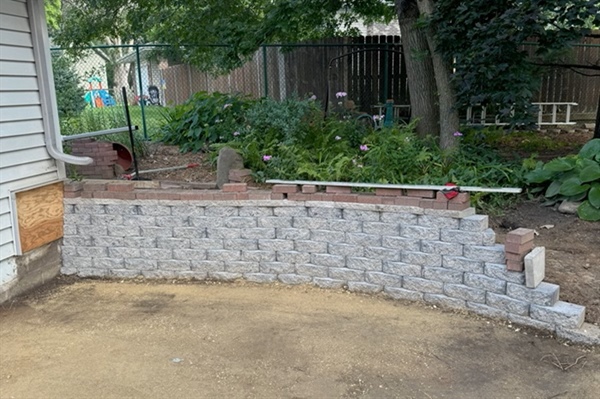What Are the Benefits of Installing Retaining Walls in Residential Landscapes?

Retaining walls are crucial in residential landscapes, offering both functional and aesthetic benefits. These structures stabilize sloped areas, prevent soil erosion, and help homeowners maximize their outdoor space. Whether constructed from concrete, natural stone, or wood, retaining walls create a strong boundary that supports landscaping elements and improves a property's overall appearance.
Beyond their practical use, retaining walls also contribute to the visual appeal of outdoor spaces. Our team explores key aspects of retaining walls, including how they prevent soil erosion, the materials used in their construction, their integration into landscape aesthetics, important structural considerations, and their role in creating level areas on sloped properties.
How Do Retaining Walls Prevent Soil Erosion?
Soil erosion is common for homeowners, particularly in areas with uneven terrain or heavy rainfall. Retaining walls provide an effective solution by acting as a barrier that holds soil in place and prevents it from washing away. These walls reduce surface runoff by breaking the water flow, allowing moisture to be absorbed into the ground rather than eroding the soil. Properly engineered retaining walls are essential for maintaining the integrity of a landscape and preventing costly damage to a property’s foundation.
The design and structure of retaining walls also influence their ability to prevent erosion. Drainage systems, such as weep holes or perforated pipes, help direct excess water away from the soil, minimizing the risk of water-related erosion. When constructed with the right materials and engineering techniques, retaining walls can significantly reduce the impact of erosion on residential landscapes, ensuring long-term stability.
What Materials Are Commonly Used for Building Retaining Walls?
Retaining walls can be constructed using a variety of materials, each offering unique benefits in terms of durability, aesthetics, and cost. Common materials include concrete blocks, natural stone, brick, wood, and gabion walls (wire mesh filled with stones). The choice of material depends on factors such as soil conditions, climate, and the desired appearance of the landscape.
Concrete retaining walls are highly durable and can withstand significant pressure from soil and water. They offer a modern look and can be designed in various shapes and textures. Natural stone and brick walls provide a classic, elegant appeal, blending seamlessly with gardens and outdoor features. Wooden retaining walls, though less durable than stone or concrete, are cost-effective and add a rustic charm to landscapes.
Each material has advantages and maintenance requirements. When planning a retaining wall project, homeowners should consider the longevity and aesthetic compatibility of the material. Consulting with a professional can ensure the right material is selected for long-term stability and visual appeal.
How Can Retaining Walls Be Integrated into Landscape Design for Aesthetic Appeal?
Retaining walls are not just structural elements—they also play a key role in enhancing the beauty of outdoor spaces. When designed strategically, they can add dimension, create garden beds, and define functional spaces within a landscape. Retaining walls can be built with decorative elements such as natural stone finishes, textured concrete, or even built-in seating areas.
For homeowners who want to create a harmonious outdoor environment, retaining walls can be combined with plantings, waterfalls, or outdoor lighting to enhance their visual impact. Multi-tiered retaining walls add depth and variation to a yard, allowing for creative landscaping opportunities, such as raised flower beds and terraced gardens.
Professional landscape designers often use retaining walls to create focal points in outdoor spaces. Retaining walls can significantly elevate a property's overall aesthetic when integrated with pathways, patios, or water features.
What Are the Structural Considerations for Building a Durable Retaining Wall?
The strength and longevity of a retaining wall depend on various structural factors, including proper foundation preparation, drainage management, and load-bearing capacity. The base of a retaining wall must be deep and well-compacted to prevent shifting or collapse over time. A solid foundation ensures the wall can withstand soil pressure and environmental changes.
Drainage is another critical factor in maintaining a durable retaining wall. Without proper drainage, water can build up behind the wall, increasing hydrostatic pressure and leading to structural failure. Solutions such as gravel backfill, perforated pipes, and weep holes help manage water flow and maintain the wall’s stability.
Other considerations include choosing the right type of reinforcement, such as geogrid reinforcement for taller walls. Proper engineering and material selection will determine how well a retaining wall performs over time, making expert guidance essential for long-lasting results.
How Do Retaining Walls Assist in Creating Level Areas on Sloped Properties?
Sloped properties present a challenge for homeowners looking to maximize usable outdoor space. Retaining walls help by creating level terraces, making it possible to develop functional areas such as patios, walkways, and gardens. By converting steep slopes into tiered sections, retaining walls allow for better space utilization and improved accessibility.
Terracing with retaining walls increases usability and helps soil retention and water management. Without these structures, rainwater can cause soil displacement and instability. By incorporating retaining walls, homeowners can create visually appealing, flat surfaces that support a variety of landscaping features.
For properties with significant elevation changes, retaining walls can be designed to include staircases or built-in seating, further enhancing accessibility and aesthetic appeal. Strategically placed retaining walls will benefit homeowners looking to improve their landscape’s functionality and appearance.
Get Professional Assistance from A-1 Curb Appeal
Installing a retaining wall requires expertise to ensure structural integrity, durability, and aesthetic appeal. A-1 Curb Appeal specializes in designing and building high-quality retaining walls that enhance function and beauty in residential landscapes. Whether you need erosion control, material selection guidance, or a customized landscape design, our team has the skills and experience to deliver top-tier results.
For professional retaining wall installation and landscaping services, contact A-1 Curb Appeal today. We proudly serve homeowners in Farmington, MN, and surrounding areas. Call us at 763-587-8929 for a free estimate or visit our website for more information on how we can transform your outdoor space.